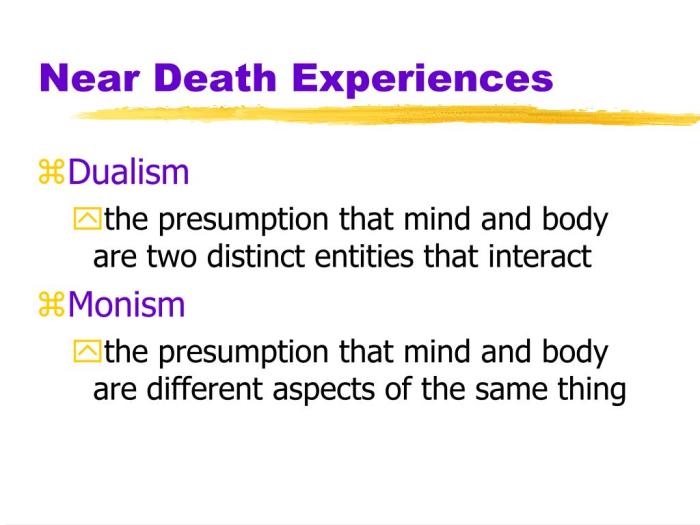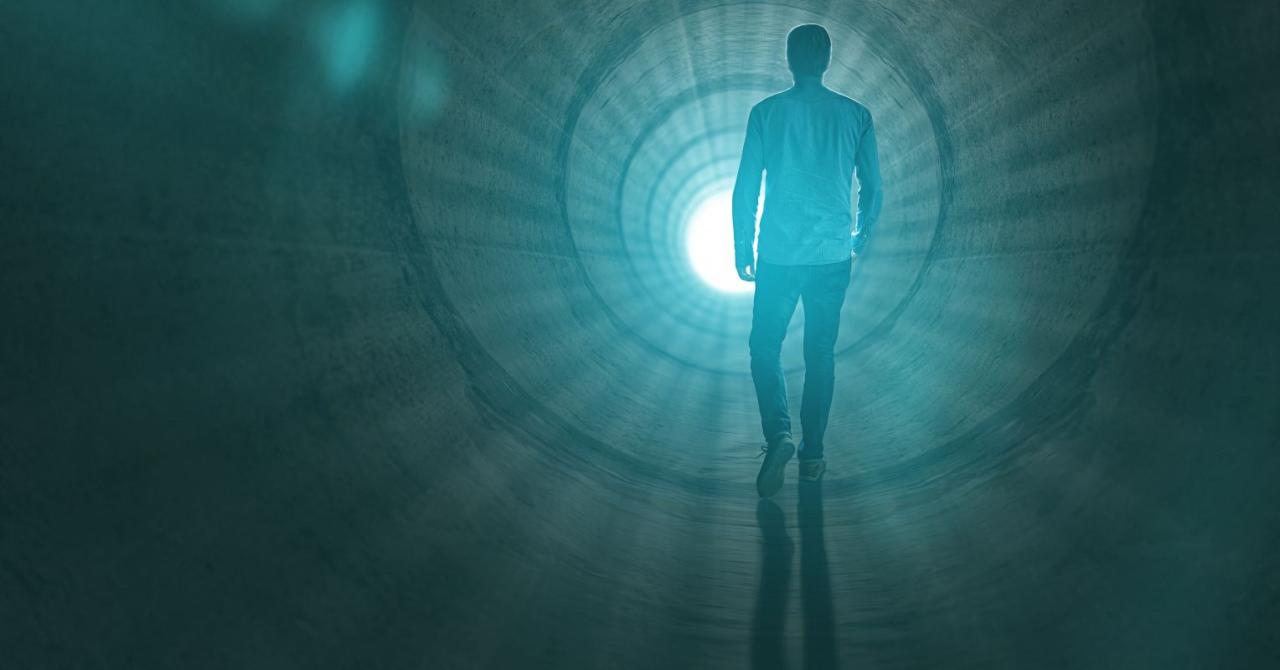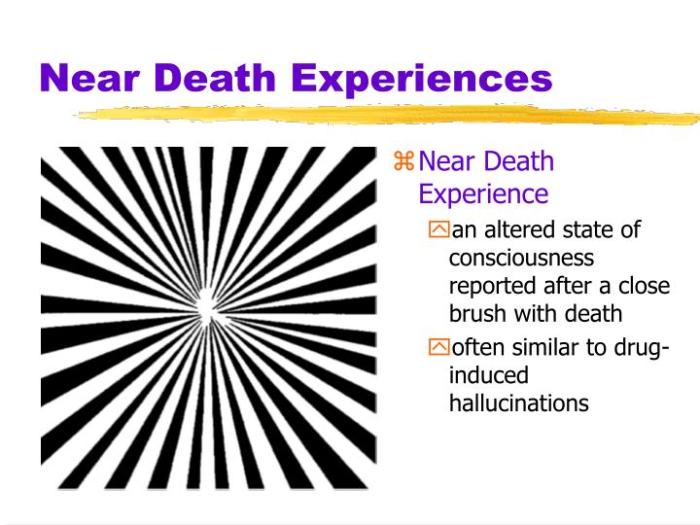Near death experience ap psychology – Near death experience (NDE) is a profound and often transformative event that has been reported by individuals who have come close to death. These experiences can vary widely, but they often share certain common elements, including altered perceptions of time and space, encounters with deceased loved ones or spiritual beings, and feelings of peace and tranquility.
NDE research offers valuable insights into the nature of consciousness, the afterlife, and the human experience. This article will explore the psychological and physiological aspects of NDEs, discuss the subjective experiences reported by individuals who have had NDEs, and examine the cultural and religious influences that shape the interpretation of these experiences.
Definition of Near-Death Experience (NDE)

A near-death experience (NDE) refers to a profound psychological event that individuals report having when they come close to death or during a life-threatening situation.
NDE accounts often share common characteristics, including a sense of peace and tranquility, a feeling of being separated from one’s body, encountering deceased loved ones or spiritual beings, and a review of one’s life.
Cultural and Historical Perspectives
NDE experiences have been reported across various cultures and historical periods, with similarities in core elements despite cultural differences.
- Ancient Egyptian texts describe NDEs involving encounters with deities and journeys to the afterlife.
- In Tibetan Buddhism, the “Bardo Thodol” (Tibetan Book of the Dead) details the stages of consciousness experienced during NDEs.
- Contemporary NDE accounts from Western cultures often involve similar themes of peace, separation from the body, and encounters with light.
Psychological and Physiological Aspects of NDEs

Near-death experiences (NDEs) have captivated the interest of researchers from various fields, including psychology and medicine. These experiences often involve profound psychological and physiological changes, leading to the development of numerous theories and hypotheses.
Psychological Theories of NDEs
Several psychological theories have been proposed to explain the subjective experiences reported during NDEs. One prominent theory is the tunnel theory, which suggests that the near-death experience involves a sense of moving through a dark tunnel or passageway. This theory is often linked to the release of endorphins during the dying process, which can produce feelings of euphoria and detachment.
Another psychological theory is the afterlife hypothesis, which posits that NDEs provide a glimpse into an afterlife or spiritual realm. This theory is based on the belief that consciousness exists beyond the physical body and that it continues after death. Proponents of this hypothesis argue that NDEs offer evidence of a non-physical realm that exists beyond the material world.
Physiological Changes during NDEs
In addition to the psychological theories, there have also been significant physiological changes observed during NDEs. These changes include:
- Brain activity: Studies have shown that NDEs are associated with increased activity in certain areas of the brain, particularly the temporal lobes and the parietal lobes. These areas are involved in processing sensory information, emotions, and self-awareness.
- Oxygen deprivation: Near-death experiences can also be triggered by oxygen deprivation to the brain. When the brain is deprived of oxygen, it can lead to a release of neurotransmitters that can produce hallucinations and other altered states of consciousness.
The physiological changes that occur during NDEs are believed to contribute to the subjective experiences reported by individuals who have had these experiences.
Subjective Experiences during NDEs

Individuals who have had NDEs often report a wide range of subjective experiences that can be categorized into several distinct phenomena. These experiences include altered perceptions of time and space, encounters with deceased loved ones or spiritual beings, and feelings of peace and tranquility.
Altered Perception of Time and Space
During NDEs, individuals may experience a profound alteration in their perception of time and space. Time may seem to slow down or speed up, and space may appear to expand or contract. Some individuals report feeling as if they are floating or flying through a tunnel or void.
Encounters with Deceased Loved Ones or Spiritual Beings
Many individuals who have had NDEs report encountering deceased loved ones or spiritual beings. These encounters can range from brief glimpses to extended conversations. The deceased loved ones often appear as younger and healthier versions of themselves, and they may offer words of comfort or guidance.
Feelings of Peace and Tranquility
A common feature of NDEs is a profound sense of peace and tranquility. Individuals may feel a sense of weightlessness, warmth, and love. They may also experience a sense of unity with the universe or a higher power.
Cultural and Religious Influences on NDEs: Near Death Experience Ap Psychology

Cultural and religious beliefs significantly shape the interpretation and experiences of near-death experiences (NDEs). Across different societies, NDEs are interpreted through the lens of prevailing cultural norms, religious doctrines, and personal beliefs.
Religious Interpretations
- Christianity:NDEs are often interpreted as glimpses of heaven or hell, with emphasis on divine judgment and eternal life.
- Buddhism:NDEs are seen as a transitional state between life and reincarnation, with a focus on spiritual growth and enlightenment.
- Islam:NDEs are believed to be encounters with the angel of death and a glimpse of the afterlife, with emphasis on divine mercy and forgiveness.
Cultural Influences
Cultural expectations also influence the subjective experiences of NDEs:
- Western cultures:NDEs are often described as out-of-body experiences, encounters with deceased loved ones, and visions of bright lights or tunnels.
- Eastern cultures:NDEs are more likely to involve spiritual awakenings, encounters with deities or mythical beings, and a sense of unity with the universe.
- Indigenous cultures:NDEs may be interpreted as shamanic journeys, encounters with ancestral spirits, or transformations into animal or plant forms.
Ethical Considerations in Studying NDEs

Ethical considerations are crucial in researching and discussing near-death experiences (NDEs) to ensure the privacy, dignity, and well-being of individuals who have had such experiences. Additionally, it is essential to avoid sensationalism and exploitation that may undermine the integrity of the research and the experiences themselves.
Respecting Privacy and Beliefs, Near death experience ap psychology
Researchers must respect the privacy and beliefs of individuals who have had NDEs. This includes obtaining informed consent before conducting interviews or using personal information. It is also important to maintain confidentiality and anonymity to protect the privacy of participants and avoid any potential harm or stigmatization.
Avoiding Sensationalism and Exploitation
Researchers and the media should avoid sensationalizing NDEs or exploiting them for entertainment purposes. NDEs are deeply personal and often transformative experiences that should be treated with respect and sensitivity. Sensationalism and exploitation can trivialize these experiences and undermine their credibility.
Applications of NDE Research

Near-death experience (NDE) research offers valuable insights into the nature of human consciousness, the end-of-life experience, and the potential for life after death. The findings from NDE studies have diverse applications in various fields, including palliative care, end-of-life counseling, and the exploration of consciousness and the afterlife.
Palliative Care and End-of-Life Counseling
NDE research provides valuable insights for healthcare professionals working in palliative care and end-of-life counseling. Understanding the common subjective experiences reported during NDEs, such as feelings of peace, tranquility, and connection to a higher power, can help healthcare providers better support patients and their families during this challenging time.
By incorporating NDE research into their practice, healthcare professionals can:
- Enhance their understanding of the emotional and spiritual needs of patients facing end-of-life issues.
- Provide more compassionate and informed care, addressing the fears and anxieties associated with death.
- Facilitate meaningful conversations about death and the afterlife, empowering patients to make informed decisions about their end-of-life care.
Understanding the Nature of Consciousness and the Afterlife
NDE research has the potential to contribute to our understanding of the nature of consciousness and the possibility of life after death. The subjective experiences reported during NDEs, such as out-of-body experiences, encounters with deceased loved ones, and a sense of purpose or destiny, challenge traditional scientific assumptions about the mind and its relationship to the body.
By exploring NDEs, researchers can:
- Investigate the nature of consciousness beyond the physical brain, exploring the possibility of a non-physical component to human existence.
- Examine the evidence for and against the existence of an afterlife, providing insights into the nature of death and the continuation of consciousness after physical death.
- Contribute to a deeper understanding of the human mind and its potential for transcending physical limitations.
Question & Answer Hub
What are the most common characteristics of NDEs?
The most common characteristics of NDEs include altered perceptions of time and space, encounters with deceased loved ones or spiritual beings, feelings of peace and tranquility, and a sense of purpose or meaning.
What are the different psychological theories that attempt to explain NDEs?
There are several psychological theories that attempt to explain NDEs, including the tunnel theory, the afterlife hypothesis, and the neurochemical theory.
How do cultural and religious beliefs influence the interpretation of NDEs?
Cultural and religious beliefs can shape the way that individuals interpret their NDEs. For example, individuals from cultures that believe in reincarnation may interpret their NDE as a glimpse into their past or future lives.
